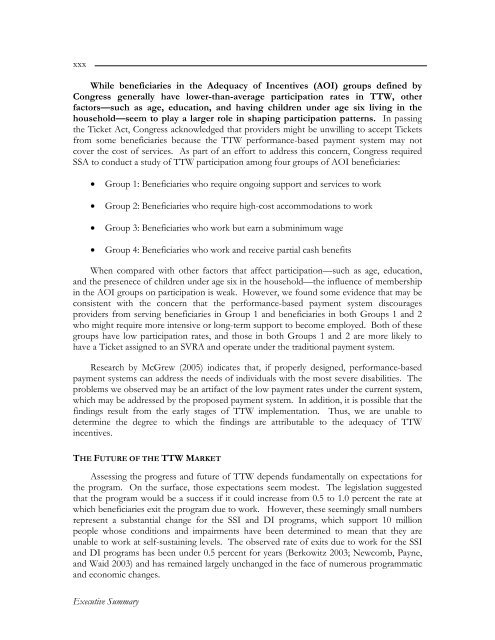Evaluation of the Ticket To Work Program - Mathematica Policy ...
Evaluation of the Ticket To Work Program - Mathematica Policy ...
Evaluation of the Ticket To Work Program - Mathematica Policy ...
You also want an ePaper? Increase the reach of your titles
YUMPU automatically turns print PDFs into web optimized ePapers that Google loves.
xxx<br />
While beneficiaries in <strong>the</strong> Adequacy <strong>of</strong> Incentives (AOI) groups defined by<br />
Congress generally have lower-than-average participation rates in TTW, o<strong>the</strong>r<br />
factors—such as age, education, and having children under age six living in <strong>the</strong><br />
household—seem to play a larger role in shaping participation patterns. In passing<br />
<strong>the</strong> <strong>Ticket</strong> Act, Congress acknowledged that providers might be unwilling to accept <strong>Ticket</strong>s<br />
from some beneficiaries because <strong>the</strong> TTW performance-based payment system may not<br />
cover <strong>the</strong> cost <strong>of</strong> services. As part <strong>of</strong> an effort to address this concern, Congress required<br />
SSA to conduct a study <strong>of</strong> TTW participation among four groups <strong>of</strong> AOI beneficiaries:<br />
�� Group 1: Beneficiaries who require ongoing support and services to work<br />
�� Group 2: Beneficiaries who require high-cost accommodations to work<br />
�� Group 3: Beneficiaries who work but earn a subminimum wage<br />
�� Group 4: Beneficiaries who work and receive partial cash benefits<br />
When compared with o<strong>the</strong>r factors that affect participation—such as age, education,<br />
and <strong>the</strong> presenece <strong>of</strong> children under age six in <strong>the</strong> household—<strong>the</strong> influence <strong>of</strong> membership<br />
in <strong>the</strong> AOI groups on participation is weak. However, we found some evidence that may be<br />
consistent with <strong>the</strong> concern that <strong>the</strong> performance-based payment system discourages<br />
providers from serving beneficiaries in Group 1 and beneficiaries in both Groups 1 and 2<br />
who might require more intensive or long-term support to become employed. Both <strong>of</strong> <strong>the</strong>se<br />
groups have low participation rates, and those in both Groups 1 and 2 are more likely to<br />
have a <strong>Ticket</strong> assigned to an SVRA and operate under <strong>the</strong> traditional payment system.<br />
Research by McGrew (2005) indicates that, if properly designed, performance-based<br />
payment systems can address <strong>the</strong> needs <strong>of</strong> individuals with <strong>the</strong> most severe disabilities. The<br />
problems we observed may be an artifact <strong>of</strong> <strong>the</strong> low payment rates under <strong>the</strong> current system,<br />
which may be addressed by <strong>the</strong> proposed payment system. In addition, it is possible that <strong>the</strong><br />
findings result from <strong>the</strong> early stages <strong>of</strong> TTW implementation. Thus, we are unable to<br />
determine <strong>the</strong> degree to which <strong>the</strong> findings are attributable to <strong>the</strong> adequacy <strong>of</strong> TTW<br />
incentives.<br />
THE FUTURE OF THE TTW MARKET<br />
Assessing <strong>the</strong> progress and future <strong>of</strong> TTW depends fundamentally on expectations for<br />
<strong>the</strong> program. On <strong>the</strong> surface, those expectations seem modest. The legislation suggested<br />
that <strong>the</strong> program would be a success if it could increase from 0.5 to 1.0 percent <strong>the</strong> rate at<br />
which beneficiaries exit <strong>the</strong> program due to work. However, <strong>the</strong>se seemingly small numbers<br />
represent a substantial change for <strong>the</strong> SSI and DI programs, which support 10 million<br />
people whose conditions and impairments have been determined to mean that <strong>the</strong>y are<br />
unable to work at self-sustaining levels. The observed rate <strong>of</strong> exits due to work for <strong>the</strong> SSI<br />
and DI programs has been under 0.5 percent for years (Berkowitz 2003; Newcomb, Payne,<br />
and Waid 2003) and has remained largely unchanged in <strong>the</strong> face <strong>of</strong> numerous programmatic<br />
and economic changes.<br />
Executive Summary
















